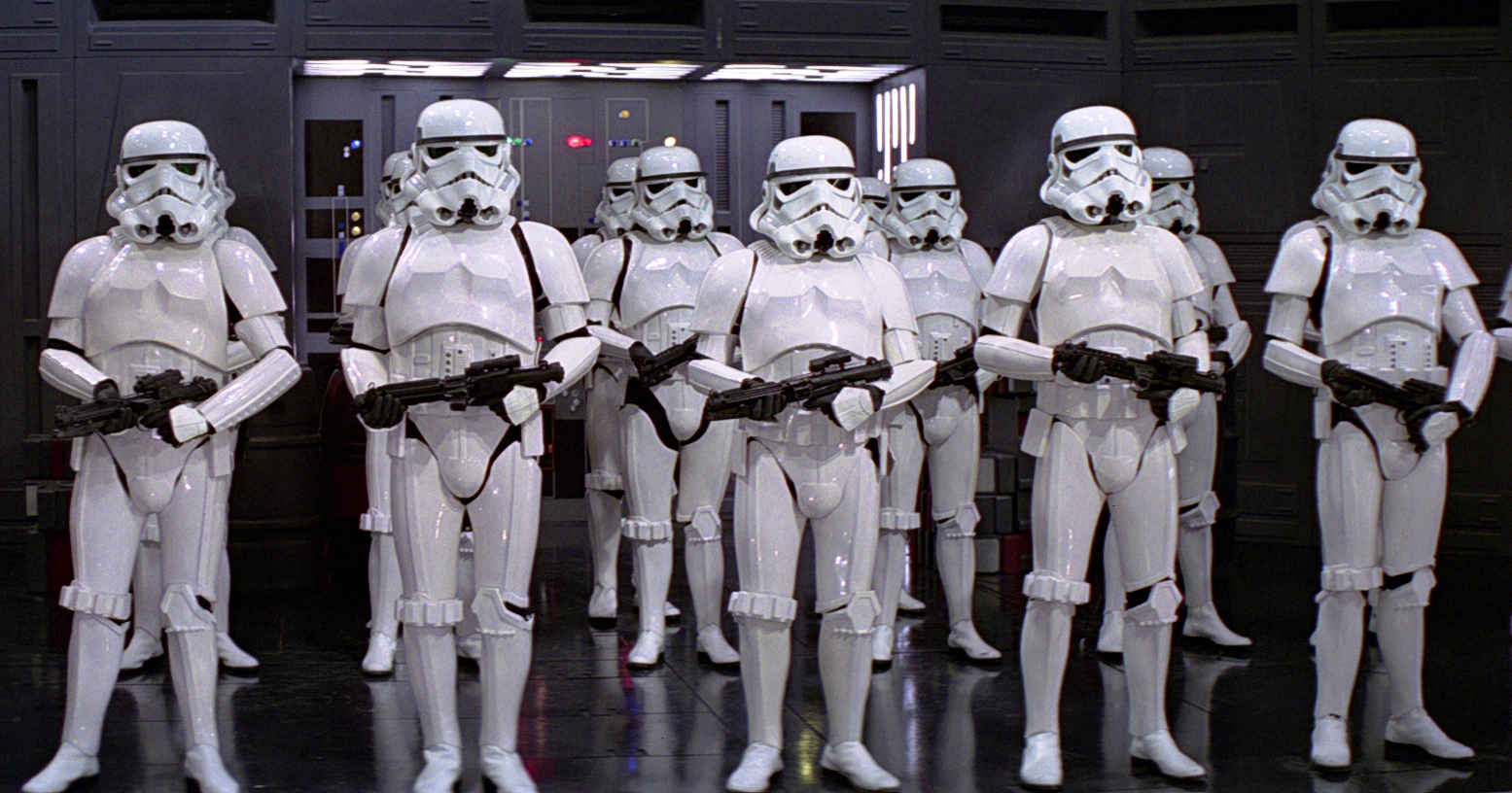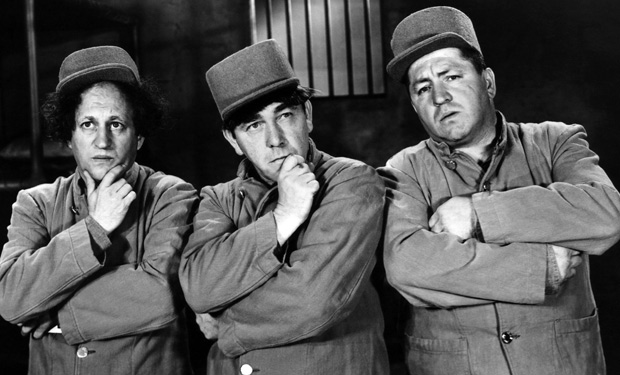Henchmen ... the underrated enablers of action fiction. Henchmen on both sides of a conflict provide a sense of context to the situation. They can die to illustrate the danger of the situation without depriving the story of a main or secondary character. The rank and file Stormtrooper, JOEs, Cobra members, even Starfleet Red Shirts. They serve by dying, enabling the story to impose an element of danger that wouldn't be there otherwise without compromising your core cast.
Henchmen also serve to highlight the capable. The named heroes, and villains, look more competent by comparison to the henchmen. They allow a hero to punch out a dozen men on his way to rescue the girl and look awesome doing it. They make the villain seem positively impressive compared to their lesser servants.
They also help to facilitate pacing. Imagine how quickly many stories would end if there was no barrier between the protagonist and the antagonist. Without goons the Batman would get up in Joker's grill with far less effort, and the JOEs would probably have arrested Cobra Commander and his lackies. Henchmen allow for one or more pacing scenes where the heroes whittle away at the villainous support, often without making meaningful headway on the villain themselves, or even while the villain is able to continue his plans (recall how the Avengers were largely tied up dealing with the Chitauri instead of dealing with Loki for much of the final act of the Avengers).
Not all henchmen are nameless and faceless. One could argue that Vader is the henchman of Palpatine and "from a certain point of view" they'd be right. However I'm concerning myself only with the nameless rank and file here. Maybe I'll do another column on those folks later.
I also want to say something right now, not all henchmen are useless saps who can't harm the hero and simply bumble their way through a scene until they meet their demise. I think this is probably the one true fault of Star Wars that the series has never managed to shake off. The Stormtroopers look badass precisely one time on film, the first scene of the first movie. After that they look like buffoons at worst, and simply not very capable at best. Henchmen should be capable and need to be able to pose a genuine threat. If they cannot do that they serve literally no purpose to the story.
Well, if my own experiences with them are any indication it could be because a lot of people don't really get the use of henchmen. It may also be that they aren't really all that well designed for some systems and that others would actually fare poorly for their use. Let's take a closer look.
As I stated before, cinematically henchmen, mooks, goons, and the like serve a variety of purposes ranging from elevating the named characters to establishing the stakes of a conflict. Often henchmen are characters who are metaphorically or literally faceless. They either never get a close up, or they have their face/head covered. Stormtroopers are a good example of the latter situation, while any number of comic book goons serve well the former. How they look isn't strictly relevant but it's good to consider the forms that henchmen can take.
At this point I'm going to start referring to henchmen as "extras" because I am lazy and there are fewer letters to type that way ...Obviously low level humanoids make for good extra, but consider that a necromancer's lesser undead, a druid's beast friends, and and elementalist's summons could all fulfill the mechanical needs of an extra for a given villain. The key take away here should be that extras are a "non-unique" enemy that is less capable than the heroes and far less capable than the big bad; what they look like does not matter.
Extras Need Not Apply
Knowing when not to use extras is often as important as knowing when to use them. Certain genres just don't mix well with extras. Horror games are a great example of this. The antagonists in horror need to feel capable and powerful, that is part in parcel with establishing the mood needed for the players to feel the dread at is part of a horror game. Since extras shouldn't be as capable as the heroes, and should be plentiful they really go against horror conventions. Horror games generally rely on the characters feeling outmatched and fighting against forces greater than themselves, and extras, which stem from pulp and comic mediums, achieve the opposite effect.
So when should you use extras? Well pulp and comics/superheroes games are ideal places for extras as they birthed the concept. These are hardly the only genres that can benefit though. High fantasy generally assumes a certain degree of capability to be invested in the heroes, and through the use of extras this can be highlighted easily. Likewise science fiction, depending on its flavor can make good use of extras as a way to show the power of the high tech weaponry, and consequently the high tech armor or defenses of the main villain.
Glass Jaws
When it comes to the execution of extras in RPGs I have seen plenty of variations, but generally they rely on a unifying factor across any system: the have glass jaws. Different systems accomplish this in different ways. Games that use hit points simply give these extras a bare minimum; if you average sword does 2d6 damage any enemy with 7 or less hit points is going to fall in one hit more than 50% of the time.
That one hit factor is key. Mutants & Masterminds (a favorite supers RPG of mine) uses a damage resistance system instead of hit points. You make a save based on your "toughness" (a bonus) against a target DC set by the damage of the attack. For heroes failure incurs various penalty conditions; for extras failure means being taken out. Again a simple one hit rule.
Some game systems go farther and actually codify extras as being "1 hit" extras, you don't even need to roll damage, if you hit them once they fall. Sometimes you'll even see "2 hit" or "3 hit" extras in these systems to dial in difficulty even farther. And that is a useful way to look at extras; how many hits should this guy take before he falls? This has its ups and downs of course. If you have a character built to deal out lots of damage he'll still need to hit twice to down a "2 hit" extra. This might be a negative game experience for some players who feel cheated that their bruiser isn't hyper capable, so consider the damage mechanism of your game before implementing something as simple as "x hit" extras.
Going back to the original example though. If the average character is going to deal 2d6 damage and some will deal more if built to do so you can take that average value, 7 hit points, as "1 hit" and then scale. A "2 hit" extra in such systems would have 14 hit points, and a "1.5 hit" extra would have 10 (round down), enough that they gain a degree of resilience against the average attack, but would still fall to more powerful single attacks or critical hits.
Less Capable Does Not Mean Incapable
Extras shouldn't be as powerful as the PCs. I stand by this as a simple statement of base logic; glass cannons make poor enemies. That said, extras shouldn't be incapable either. If they aren't able to threaten the PCs with harm they lose whatever purpose they had. That harm need not come in the form of damage of course; a gibbering tide of tiny homunculi may not be able to injure the heroes, but they can impair their movements, carry off items that the PCs seek, and/or threaten innocents.
Some extras will be able to harm the PCs in combat though. That's where some games fall flat; they link health to combat capability. A high fantasy game with "1 hit" type goblins is great for the heroes to feel powerful as they delve a dungeon to find the evil within, but the goblins need to have attack bonuses and strength to hurt the PCs. They make up for their fragility via numbers though so those bonuses need not be as high as a comparable non-extra since more dice will roll.
A single PC leveled threat (which we'll assume here has roughly 20 hits worth of hit points, e.g. 140 health) with an attack skill of X (where X gives them a 50/50 hit chance) and dealing Y damage could be replaced by 20 "1 hit" extras with an attack skill of X/2 (giving them a 25% chance to hit) and dealing Y/2 damage. These extras will initially hit harder than the monster; with their numbers offsetting their lowered odds to hit, and then some, they stand a good chance of doing some decent damage in the first couple of rounds. But a funny thing happens as the PCs get their hits in, the extras begin to dwindle and their combat effectivity decreases accordingly, and rapidly.
Unlike the single creature with a flat damage output over time (Y damage per round if it is expected to hit most of the time) the group of extras will start strong (probably doing five hits for a total of 2.5Y damage) and decline, giving the PCs some early threat before being mopped up like the extras that they are a few rounds later as the 4-5 PCs take out probably 3-4 per round. After 1 round there will be 16 extras dealing, 4 hits, for 2Y damage; then 12 extras hitting 3 times for 1.5Y, and so on. This means that the extras will probably do more damage to the PCs (a good thing, because it makes the threat feel real) looking more threatening up front (also a good thing), BUT they will fall easily and quickly, making the PCs feel powerful (objectively a good thing, and the reason to use extras in the first place).
You can of course tweak the numbers. Reduce the damage output to Y/3 or Y/4 and the group will be only about as effective as the single monster, while still being easy for the PCs to mop up. You can leave their attack skill at X and have them do Y/10 damage, they'll hit often and deal a lot of annoying "ping" attacks. Just keep in mind that the dice aren't always 100% on the ball with probability and so you probably want to avoid skewing attack skill too low, and damage too high. Better to have a lot of reliable "ping" hits than to have a streak of good rolls that wipe out the party in what was intended as a speed bump encounter.
One could argue that you could model the group as a single entity, a swarm if you will, but then you need to deal with either multiple creature attacks (and that would either be flat damage over time or require a scaling factor based on current hit points), or deal with area of effect or multi-hit attacks, which again stay flat unless you tack more on. It can work, but it can also be more mechanical work depending on the system you use.
A good reason to stay away from swarms is also play character area of effect (AoE) attacks. Magic types often have access to fireballs and other attacks that deal damage (either scaling or evenly) over areas. Explosions, beams, cones, and the like. These attack abilities are often weaker in damage output compared to single target spells because they can hit multiple enemies. Having a group of 20 extras will allow those spells to shine... just don't clump your extras too tightly! In the prior example, the judicious use of AoE attacks might increase the kill count from 3-4 per round to 6-7 per round, this'll scale the damage output of the extras accordingly and help balance their power.
As you can see here, extras are as much about understanding how to engineer an encounter and build enemies as they are a mechanic of their own.
Non-Combat Extras
Extras are not just useful as combat mechanics, but as discussed before they can provide mechanical threats in other ways, provide the antagonist with a way to be in two places at once, or even act as an information delivery system. A good way to have the PCs learn about the antagonists can be through defeated extras. This can be done by capturing one alive and interrogating it, or by examining the remains of a dead extra. Extras can serve to help move the plot along, and because they can be dealt with quickly, they don't need to halt the flow of the game to do so.
The PCs Should Shine
Now, look, the whole point here is to make the PCs look awesome and to keep the game moving along without getting bogged down. Narratively speaking plenty of RPGs already manage this without extras as I have described them here. I wouldn't ever really feel the need for extras in a Cypher System game unless I was using the Cypher System to run Superheroes (more on that in a future column). Meanwhile I have found that the AGE system used by Dragon AGE and Fantasy AGE really needs a way to speed combat up some because even with GM and players being capable with the system combat could become a grind. Outside of combat the use of extras can help to facilitate the flow of the game by providing clues or acting as non-combat obstacles or threats.
~~~~~~~~
Lastly, I will leave you with this, because it highlights an interesting question in media: where do the villains find these chumps anyway?






No comments:
Post a Comment